Accounting & Finance Report
VerifiedAdded on 2020/02/24
|15
|1224
|47
Report
AI Summary
This report on Accounting & Finance delves into various investment strategies, the importance of shareholder wealth maximization, and the trade-offs between risk and return. It includes detailed answers to specific questions, supported by references to relevant literature, making it a valuable resource for students in finance-related courses.

Running head: ACCOUNTING & FINANCE
Accounting & Finance
Name of the University
Name of the student
Authors note
Accounting & Finance
Name of the University
Name of the student
Authors note
Paraphrase This Document
Need a fresh take? Get an instant paraphrase of this document with our AI Paraphraser
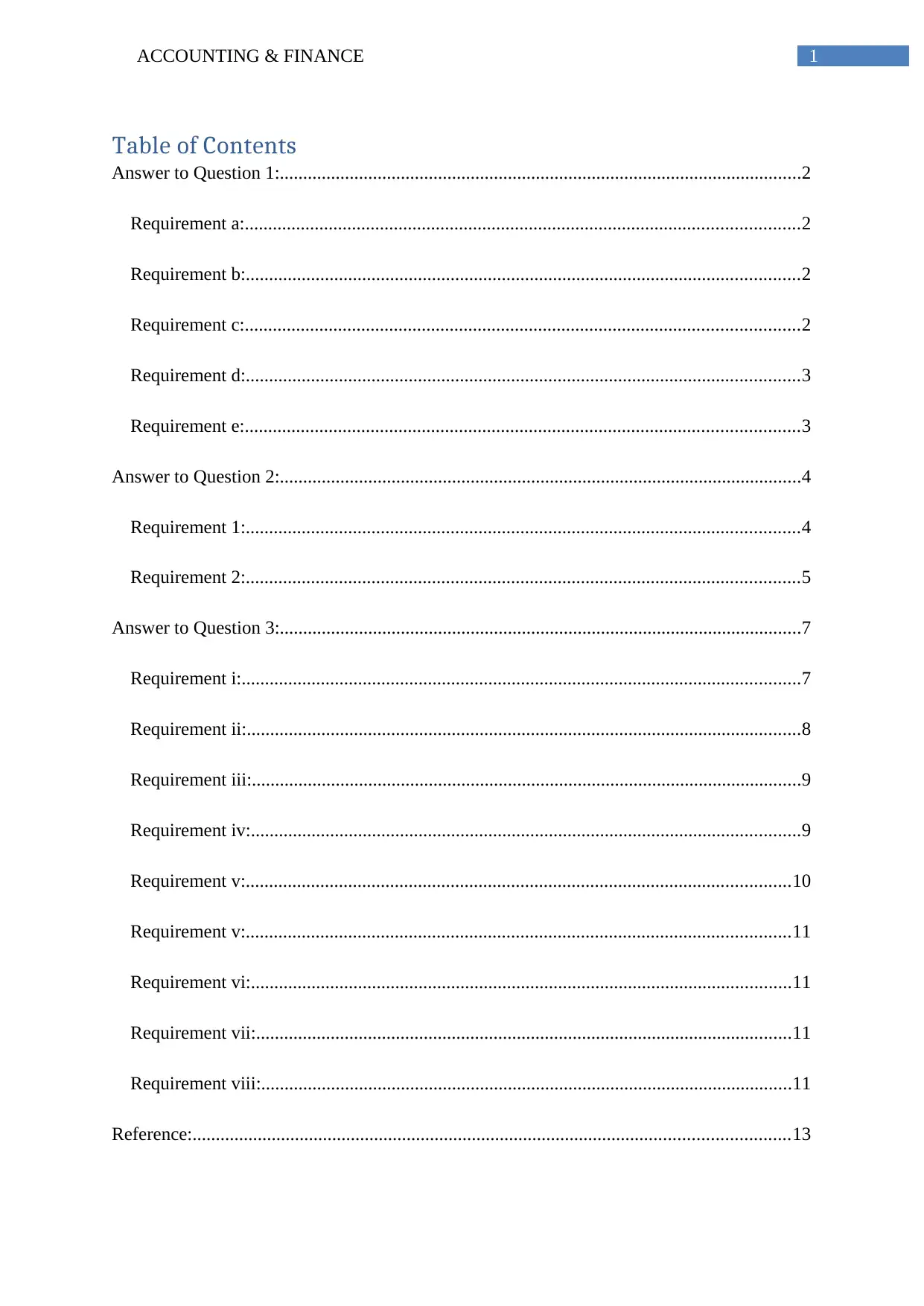
1ACCOUNTING & FINANCE
Table of Contents
Answer to Question 1:................................................................................................................2
Requirement a:.......................................................................................................................2
Requirement b:.......................................................................................................................2
Requirement c:.......................................................................................................................2
Requirement d:.......................................................................................................................3
Requirement e:.......................................................................................................................3
Answer to Question 2:................................................................................................................4
Requirement 1:.......................................................................................................................4
Requirement 2:.......................................................................................................................5
Answer to Question 3:................................................................................................................7
Requirement i:........................................................................................................................7
Requirement ii:.......................................................................................................................8
Requirement iii:......................................................................................................................9
Requirement iv:......................................................................................................................9
Requirement v:.....................................................................................................................10
Requirement v:.....................................................................................................................11
Requirement vi:....................................................................................................................11
Requirement vii:...................................................................................................................11
Requirement viii:..................................................................................................................11
Reference:................................................................................................................................13
Table of Contents
Answer to Question 1:................................................................................................................2
Requirement a:.......................................................................................................................2
Requirement b:.......................................................................................................................2
Requirement c:.......................................................................................................................2
Requirement d:.......................................................................................................................3
Requirement e:.......................................................................................................................3
Answer to Question 2:................................................................................................................4
Requirement 1:.......................................................................................................................4
Requirement 2:.......................................................................................................................5
Answer to Question 3:................................................................................................................7
Requirement i:........................................................................................................................7
Requirement ii:.......................................................................................................................8
Requirement iii:......................................................................................................................9
Requirement iv:......................................................................................................................9
Requirement v:.....................................................................................................................10
Requirement v:.....................................................................................................................11
Requirement vi:....................................................................................................................11
Requirement vii:...................................................................................................................11
Requirement viii:..................................................................................................................11
Reference:................................................................................................................................13

2ACCOUNTING & FINANCE
⊘ This is a preview!⊘
Do you want full access?
Subscribe today to unlock all pages.

Trusted by 1+ million students worldwide

3ACCOUNTING & FINANCE
Answer to Question 1:
Requirement a:
Requirement b:
Requirement c:
Answer to Question 1:
Requirement a:
Requirement b:
Requirement c:
Paraphrase This Document
Need a fresh take? Get an instant paraphrase of this document with our AI Paraphraser

4ACCOUNTING & FINANCE
Requirement d:
It is appropriate not to sale it at the current time, as would lead to a loss and this has
been shown with the help of the following table:
Requirement e:
Requirement d:
It is appropriate not to sale it at the current time, as would lead to a loss and this has
been shown with the help of the following table:
Requirement e:
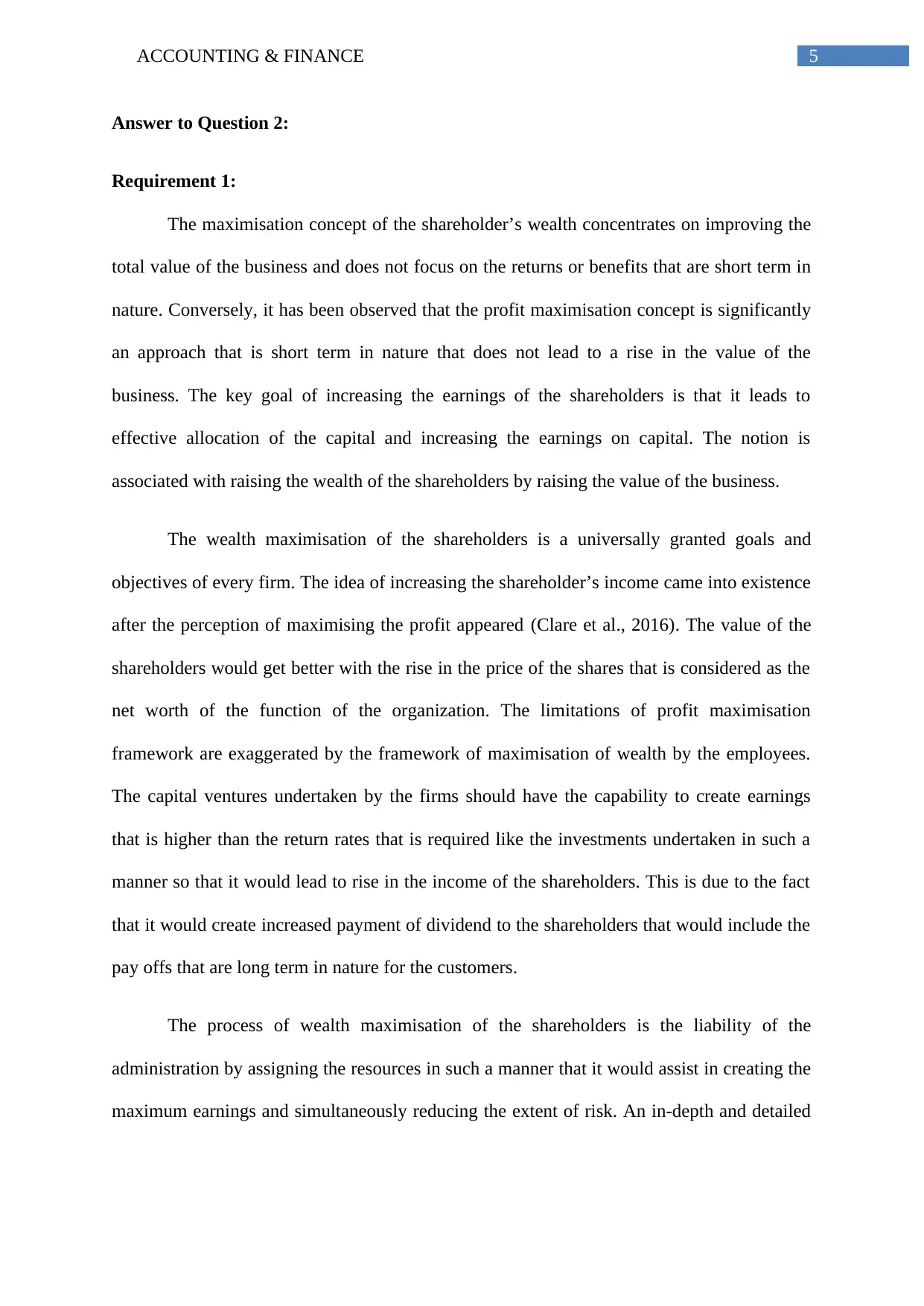
5ACCOUNTING & FINANCE
Answer to Question 2:
Requirement 1:
The maximisation concept of the shareholder’s wealth concentrates on improving the
total value of the business and does not focus on the returns or benefits that are short term in
nature. Conversely, it has been observed that the profit maximisation concept is significantly
an approach that is short term in nature that does not lead to a rise in the value of the
business. The key goal of increasing the earnings of the shareholders is that it leads to
effective allocation of the capital and increasing the earnings on capital. The notion is
associated with raising the wealth of the shareholders by raising the value of the business.
The wealth maximisation of the shareholders is a universally granted goals and
objectives of every firm. The idea of increasing the shareholder’s income came into existence
after the perception of maximising the profit appeared (Clare et al., 2016). The value of the
shareholders would get better with the rise in the price of the shares that is considered as the
net worth of the function of the organization. The limitations of profit maximisation
framework are exaggerated by the framework of maximisation of wealth by the employees.
The capital ventures undertaken by the firms should have the capability to create earnings
that is higher than the return rates that is required like the investments undertaken in such a
manner so that it would lead to rise in the income of the shareholders. This is due to the fact
that it would create increased payment of dividend to the shareholders that would include the
pay offs that are long term in nature for the customers.
The process of wealth maximisation of the shareholders is the liability of the
administration by assigning the resources in such a manner that it would assist in creating the
maximum earnings and simultaneously reducing the extent of risk. An in-depth and detailed
Answer to Question 2:
Requirement 1:
The maximisation concept of the shareholder’s wealth concentrates on improving the
total value of the business and does not focus on the returns or benefits that are short term in
nature. Conversely, it has been observed that the profit maximisation concept is significantly
an approach that is short term in nature that does not lead to a rise in the value of the
business. The key goal of increasing the earnings of the shareholders is that it leads to
effective allocation of the capital and increasing the earnings on capital. The notion is
associated with raising the wealth of the shareholders by raising the value of the business.
The wealth maximisation of the shareholders is a universally granted goals and
objectives of every firm. The idea of increasing the shareholder’s income came into existence
after the perception of maximising the profit appeared (Clare et al., 2016). The value of the
shareholders would get better with the rise in the price of the shares that is considered as the
net worth of the function of the organization. The limitations of profit maximisation
framework are exaggerated by the framework of maximisation of wealth by the employees.
The capital ventures undertaken by the firms should have the capability to create earnings
that is higher than the return rates that is required like the investments undertaken in such a
manner so that it would lead to rise in the income of the shareholders. This is due to the fact
that it would create increased payment of dividend to the shareholders that would include the
pay offs that are long term in nature for the customers.
The process of wealth maximisation of the shareholders is the liability of the
administration by assigning the resources in such a manner that it would assist in creating the
maximum earnings and simultaneously reducing the extent of risk. An in-depth and detailed
⊘ This is a preview!⊘
Do you want full access?
Subscribe today to unlock all pages.

Trusted by 1+ million students worldwide
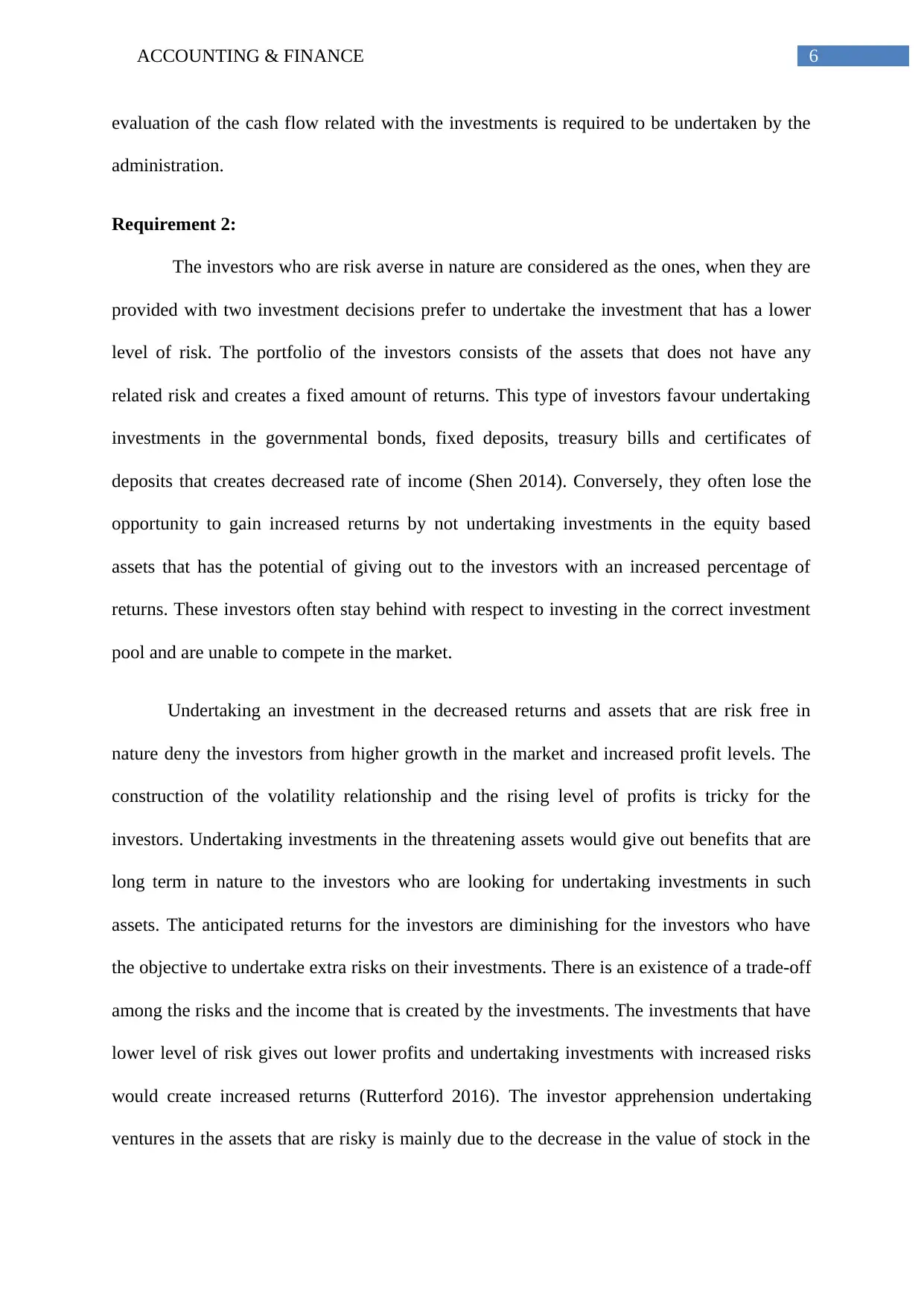
6ACCOUNTING & FINANCE
evaluation of the cash flow related with the investments is required to be undertaken by the
administration.
Requirement 2:
The investors who are risk averse in nature are considered as the ones, when they are
provided with two investment decisions prefer to undertake the investment that has a lower
level of risk. The portfolio of the investors consists of the assets that does not have any
related risk and creates a fixed amount of returns. This type of investors favour undertaking
investments in the governmental bonds, fixed deposits, treasury bills and certificates of
deposits that creates decreased rate of income (Shen 2014). Conversely, they often lose the
opportunity to gain increased returns by not undertaking investments in the equity based
assets that has the potential of giving out to the investors with an increased percentage of
returns. These investors often stay behind with respect to investing in the correct investment
pool and are unable to compete in the market.
Undertaking an investment in the decreased returns and assets that are risk free in
nature deny the investors from higher growth in the market and increased profit levels. The
construction of the volatility relationship and the rising level of profits is tricky for the
investors. Undertaking investments in the threatening assets would give out benefits that are
long term in nature to the investors who are looking for undertaking investments in such
assets. The anticipated returns for the investors are diminishing for the investors who have
the objective to undertake extra risks on their investments. There is an existence of a trade-off
among the risks and the income that is created by the investments. The investments that have
lower level of risk gives out lower profits and undertaking investments with increased risks
would create increased returns (Rutterford 2016). The investor apprehension undertaking
ventures in the assets that are risky is mainly due to the decrease in the value of stock in the
evaluation of the cash flow related with the investments is required to be undertaken by the
administration.
Requirement 2:
The investors who are risk averse in nature are considered as the ones, when they are
provided with two investment decisions prefer to undertake the investment that has a lower
level of risk. The portfolio of the investors consists of the assets that does not have any
related risk and creates a fixed amount of returns. This type of investors favour undertaking
investments in the governmental bonds, fixed deposits, treasury bills and certificates of
deposits that creates decreased rate of income (Shen 2014). Conversely, they often lose the
opportunity to gain increased returns by not undertaking investments in the equity based
assets that has the potential of giving out to the investors with an increased percentage of
returns. These investors often stay behind with respect to investing in the correct investment
pool and are unable to compete in the market.
Undertaking an investment in the decreased returns and assets that are risk free in
nature deny the investors from higher growth in the market and increased profit levels. The
construction of the volatility relationship and the rising level of profits is tricky for the
investors. Undertaking investments in the threatening assets would give out benefits that are
long term in nature to the investors who are looking for undertaking investments in such
assets. The anticipated returns for the investors are diminishing for the investors who have
the objective to undertake extra risks on their investments. There is an existence of a trade-off
among the risks and the income that is created by the investments. The investments that have
lower level of risk gives out lower profits and undertaking investments with increased risks
would create increased returns (Rutterford 2016). The investor apprehension undertaking
ventures in the assets that are risky is mainly due to the decrease in the value of stock in the
Paraphrase This Document
Need a fresh take? Get an instant paraphrase of this document with our AI Paraphraser

7ACCOUNTING & FINANCE
market. It has been observed that tax benefits are the crucial advantage of undertaking the
investments in the equity assets in the market.
It is crucial of the corporate administrators to make most favourable assignment
among the assets that are risky and the risk independent assets. There are some extra expense
that are associated in undertaking investments in the long term assets and policies that
requires to be introduced by the firm is bringing the degree of bearable threats and creates
returns that are desirable. Conversely, it can be stated that investments in the assets that are
risky leads to rise in the business risks and thus the corporate administrators should not
always make investments the assets that are risk free.
market. It has been observed that tax benefits are the crucial advantage of undertaking the
investments in the equity assets in the market.
It is crucial of the corporate administrators to make most favourable assignment
among the assets that are risky and the risk independent assets. There are some extra expense
that are associated in undertaking investments in the long term assets and policies that
requires to be introduced by the firm is bringing the degree of bearable threats and creates
returns that are desirable. Conversely, it can be stated that investments in the assets that are
risky leads to rise in the business risks and thus the corporate administrators should not
always make investments the assets that are risk free.
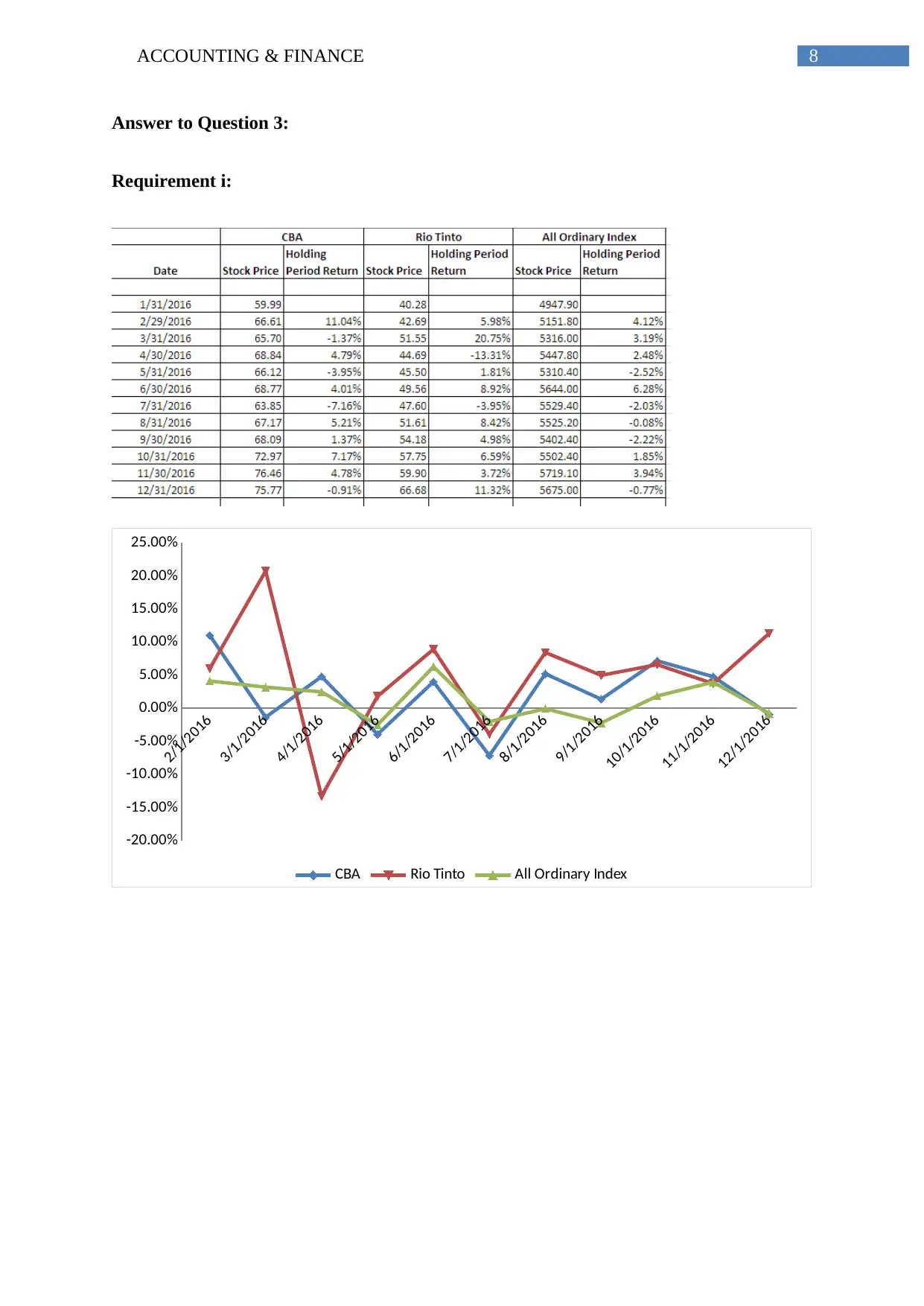
8ACCOUNTING & FINANCE
Answer to Question 3:
Requirement i:
2/1/2016
3/1/2016
4/1/2016
5/1/2016
6/1/2016
7/1/2016
8/1/2016
9/1/2016
10/1/2016
11/1/2016
12/1/2016
-20.00%
-15.00%
-10.00%
-5.00%
0.00%
5.00%
10.00%
15.00%
20.00%
25.00%
CBA Rio Tinto All Ordinary Index
Answer to Question 3:
Requirement i:
2/1/2016
3/1/2016
4/1/2016
5/1/2016
6/1/2016
7/1/2016
8/1/2016
9/1/2016
10/1/2016
11/1/2016
12/1/2016
-20.00%
-15.00%
-10.00%
-5.00%
0.00%
5.00%
10.00%
15.00%
20.00%
25.00%
CBA Rio Tinto All Ordinary Index
⊘ This is a preview!⊘
Do you want full access?
Subscribe today to unlock all pages.

Trusted by 1+ million students worldwide
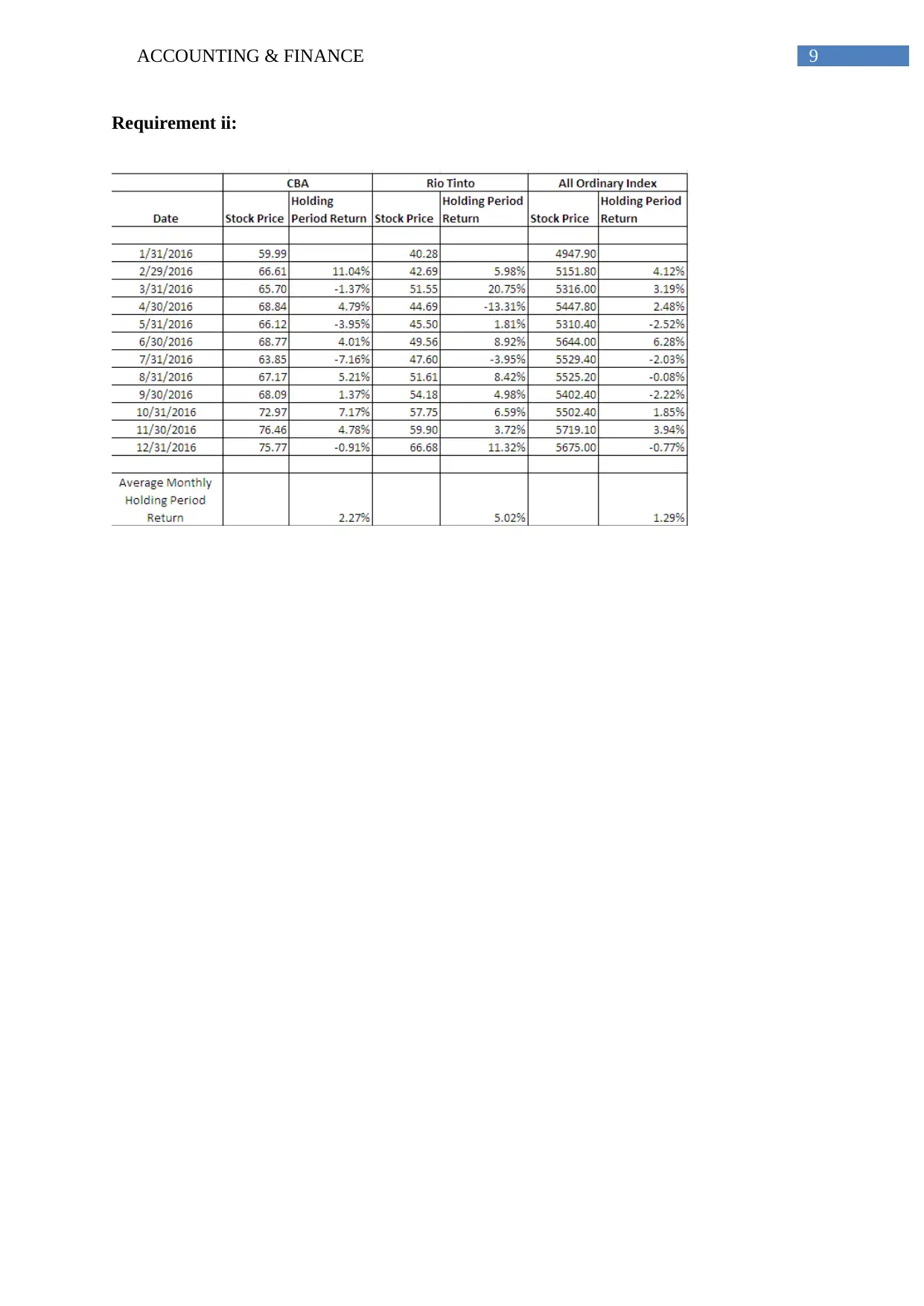
9ACCOUNTING & FINANCE
Requirement ii:
Requirement ii:
Paraphrase This Document
Need a fresh take? Get an instant paraphrase of this document with our AI Paraphraser
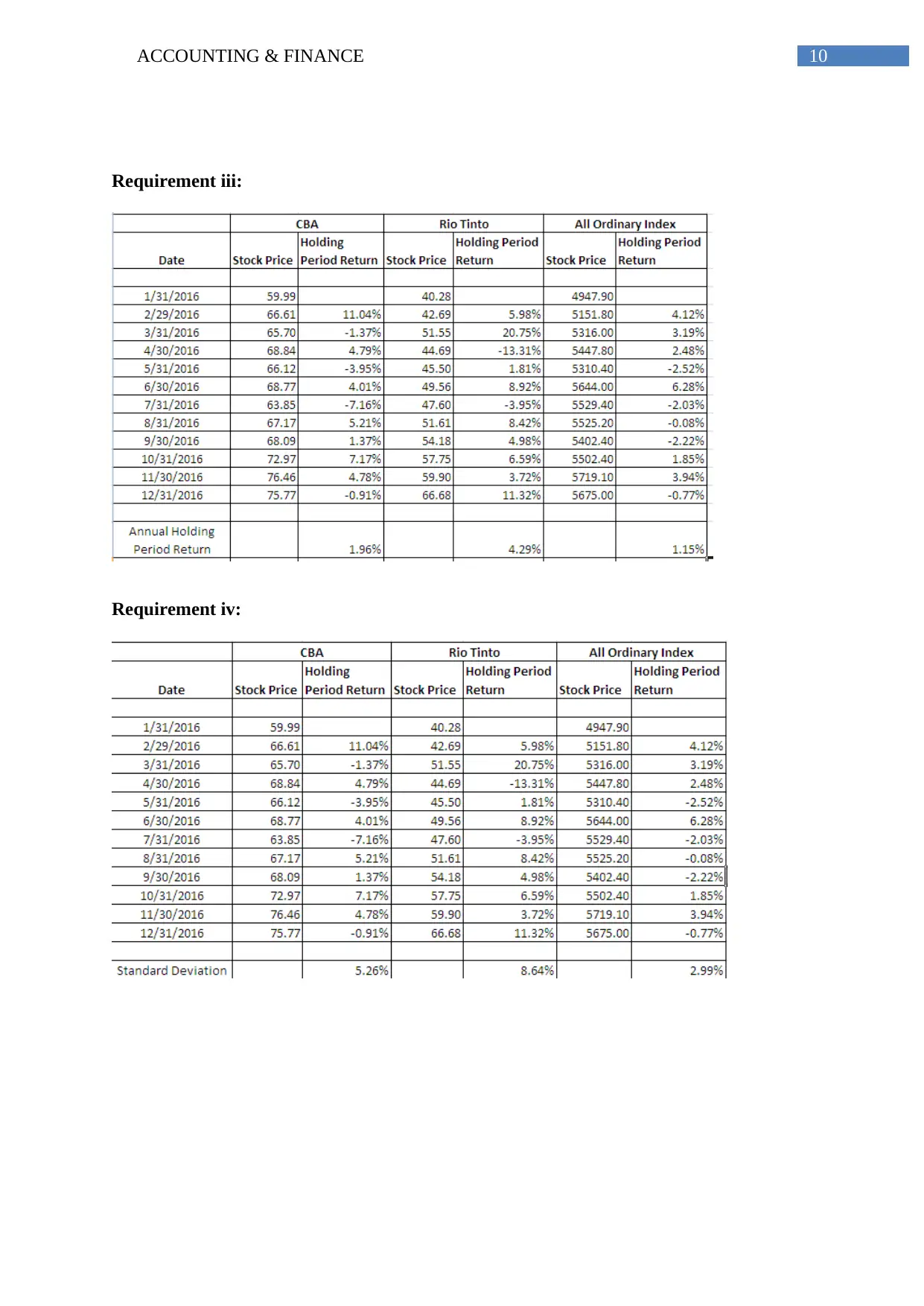
10ACCOUNTING & FINANCE
Requirement iii:
Requirement iv:
Requirement iii:
Requirement iv:

11ACCOUNTING & FINANCE
Requirement v:
0% 1% 2% 3% 4% 5% 6% 7% 8% 9% 10%
0%
1%
2%
3%
4%
5%
Series2 CBA Rio Tinto
Requirement v:
0% 1% 2% 3% 4% 5% 6% 7% 8% 9% 10%
0%
1%
2%
3%
4%
5%
Series2 CBA Rio Tinto
⊘ This is a preview!⊘
Do you want full access?
Subscribe today to unlock all pages.

Trusted by 1+ million students worldwide
1 out of 15
Related Documents
Your All-in-One AI-Powered Toolkit for Academic Success.
+13062052269
info@desklib.com
Available 24*7 on WhatsApp / Email
![[object Object]](/_next/static/media/star-bottom.7253800d.svg)
Unlock your academic potential
Copyright © 2020–2025 A2Z Services. All Rights Reserved. Developed and managed by ZUCOL.





